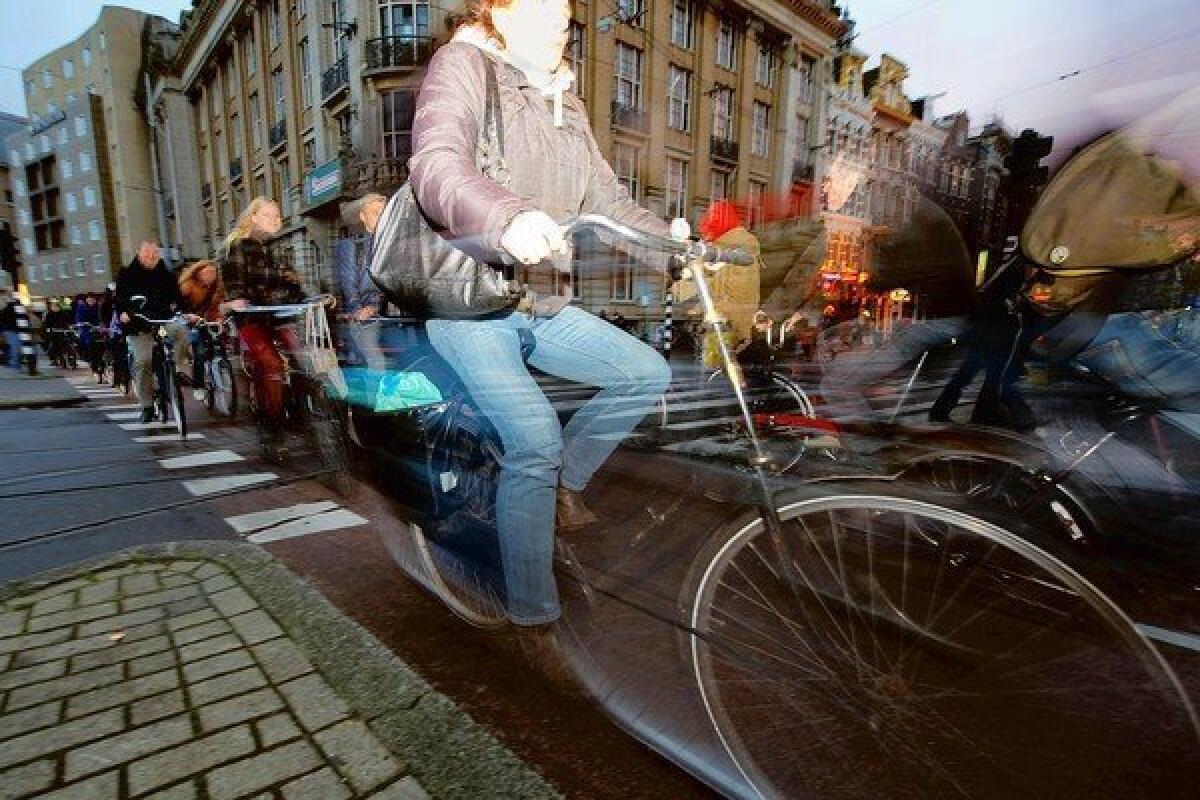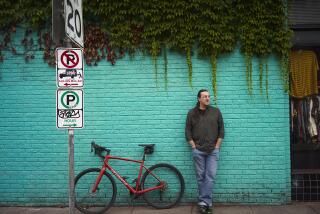A spin through a world where bicycles rule streets

- Share via
In bike-unfriendly cities such as Los Angeles, people who love cycling speak in wistful tones about a faraway place where the bike reigns supreme.
Go to Amsterdam, they say. In that mecca of the bike, you will find special roads set apart for cyclists, protected from the dangerous automobile by concrete barriers. But more than that, you will find a city where biking is part of everyday life. A city where executives, working stiffs and hand-holding lovers all pedal side by side.
Pete Jordan, a native Californian, went to Amsterdam several years ago on a biking pilgrimage. He’s still there. And his new book, “In the City of Bikes: The Story of the Amsterdam Cyclist,” is a funny, engaging and exhaustively researched tribute to Amsterdam’s unique biking history.
But more than that, “In the City of Bikes” is a portrait of one man’s obsession.
To live in biking heaven, Jordan, the author of the memoir “Dishwasher,” takes a series of menial jobs in Amsterdam. He studies Dutch and rides from one end of Amsterdam to the other, day and night. When the locals ask him why he, an educated American, is scrubbing floors in Holland, he revels in giving this cryptic answer: “So I can be stuck in a bicycle traffic jam at midnight.”
The Dutch don’t quite get Jordan. Bikes are just part of who they are. “To them, bicycles were as a natural as air or water — and hardly anything special,” he writes. But Jordan has always thought bikes were special. He begins his book by telling us, briefly, about his San Francisco childhood, and a rite of passage many a Californian will find familiar: the acquisition of his first, prized bike, a “puke-green” affair from a toy store that bears the name “Dill Pickle.”
In adulthood, Jordan’s love of bikes only grows. Sadly, most Americans don’t share his fixation. The most bikes he sees in the U.S. on an ordinary workday is in Portland, Ore.: 19 bikes at one intersection in a half-hour. In Amsterdam, it’s almost impossible to count all the bikes he sees. “Ha!” he writes. “Now I was seeing 19 cyclists just about every thirty seconds.”
Jordan is an honest, self-effacing narrator, and there’s much that’s lovably comic about his inauguration into Amsterdam cyclo-culture. Not everything about the Dutch bike scene is rosy. He learns the swear words bikers shout at one another. Paying the bike tax is a pain. He discovers there’s a brisk trade in stolen bikes. And hardly any cyclist bothers to obey the traffic laws.
None of this deters Jordan’s rampant cyclophilia. Yet he can’t find many books about Dutch biking history, so he starts to research the subject himself. Most of the nearly 400 pages of “In the City of Bikes,” in fact, concern themselves with a breezy, highly detailed account of the origins and history of Dutch bicycle culture.
Once upon a time, Americans actually biked more than the Dutch. But then the automobile was invented. Cars chased most bicycles off U.S. streets. The Dutch, living in a small country with little free space, never quite allowed that to happen.
As he recounts this history, Jordan is relentless in his pursuit of Dutch biking trivia. It seems just about any and every famous person who ever rode a bike in Amsterdam or who wrote about the city’s cycling scene earns a cameo, including Audrey Hepburn, Albert Camus and Virginia Woolf. In 1935, Woolf wrote in her diary that “the cyclists go in flocks like starlings, gathering together, skimming in & out.”
In that passage, and others, Jordan’s cyclomania makes for engaging reading. But in his lengthy discussion of the fate of Amsterdam’s bicycles during the Nazi occupation of the Netherlands in World War II, he starts to lose a bit of perspective.
When the Nazis banned most Dutch Jews from owning bicycles, Anne Frank’s mother gave hers away to a non-Jewish friend for safekeeping. After the Frank family is hauled off to a concentration camp, one of the people who helped hide them is arrested — we learn in “In the City of Bikes” that he was sent to a labor camp where he was forced to use parts from Dutch bikes to keep German bikes rolling. It seems a bit tone-deaf to seek details of Dutch biking history in one of the defining stories of the Holocaust. But for an author who’s decided to thoroughly lose himself in cycling history, the Frank family’s bicycle connections were clearly impossible to ignore.
Jordan eventually makes the bike the center of nearly every aspect of his life. When his girlfriend, Amy Joy, moves to Amsterdam, she becomes a bike mechanic. As the couple settle down in their new home, many of the cycles of family life (forgive the pun) play themselves out on a bicycle too: Jordan and the pregnant Joy ride a bike to the hospital when she goes into labor.
In Jordan’s account of the recent history of the Amsterdam biking scene, there are lessons for Angelenos and residents of other bike-unfriendly cities. If you want a cycling paradise, you’re going to have to fight for it. The Dutch did, especially in the counterculture 1970s, in protests and policy fights with cycling’s universal enemy, the automobile. Nor will bike culture ever lose its detractors: plenty of Dutch people still equate bikes with chaos.
“In the City of Bikes” is an insightful book. And it’s an especially enjoyable one for anyone who’s ever thought the world would be a better place if more people rode bikes to work — and if they rode them to the hospital to deliver their babies too.
In the City of Bikes
The Story of the Amsterdam Cyclist
Pete Jordan
Harper Perennial: 448 pp., $15.99 paper
More to Read
Sign up for our Book Club newsletter
Get the latest news, events and more from the Los Angeles Times Book Club, and help us get L.A. reading and talking.
You may occasionally receive promotional content from the Los Angeles Times.








